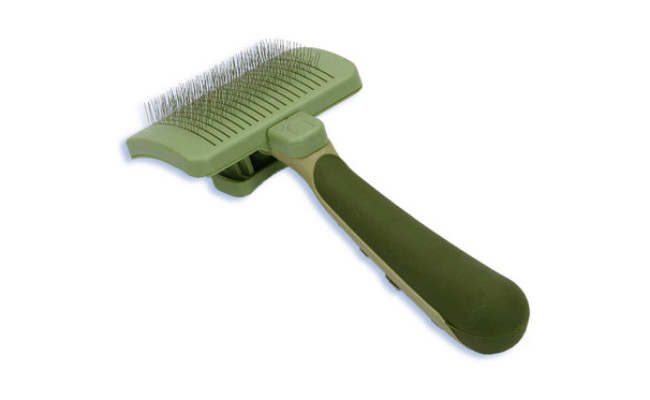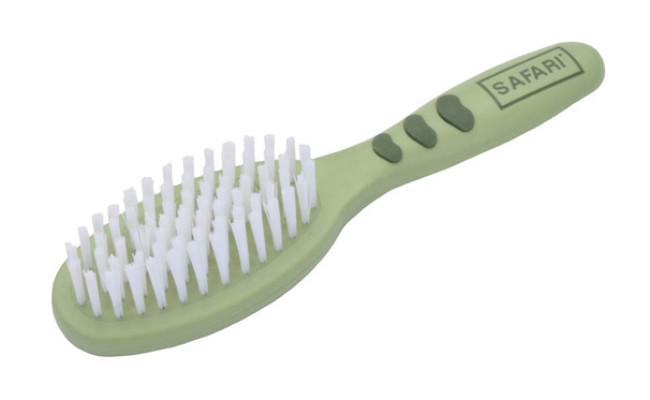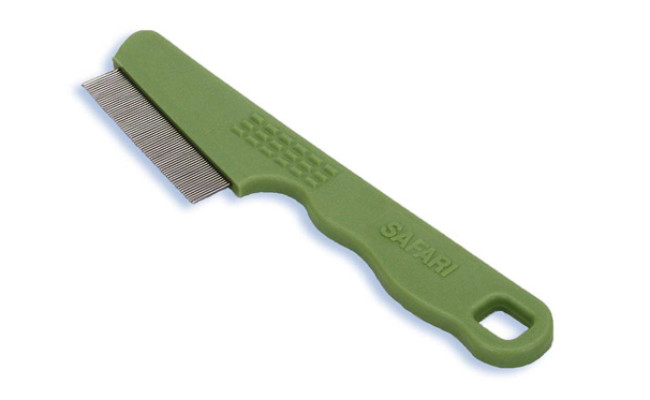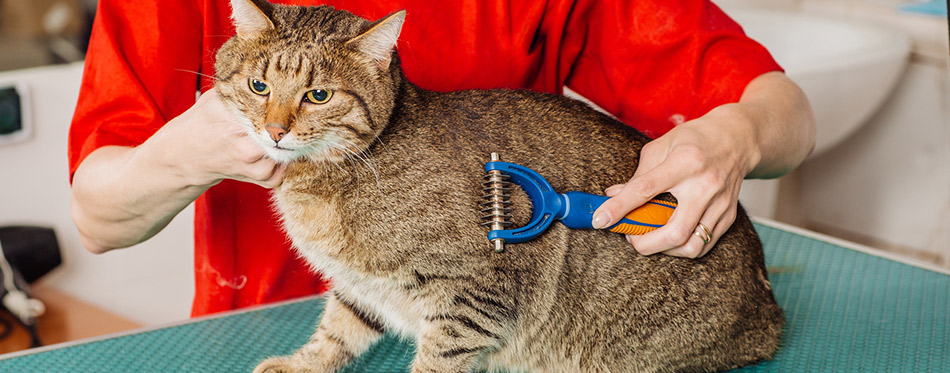
The Best Brush For Cats in 2022
- Home
- Cats
- Cat Equipment
- Cat Grooming Equipment
It’s no secret that cats have high standards of personal hygiene. Anyone who owns a kitty knows that felines like to spend a huge proportion of their waking time grooming themselves. And they certainly have the tools to do it! Their tongues come equipped with tiny barbs called papillae that help collect loose hair and dirt from their coats as they groom themselves. They pick larger or ingrained debris out of their coats with their teeth, while their paws are used to clean areas they can’t reach with their tongues. There’s no doubt that cats are highly efficient self-grooming machines, but there are flaws to the process. The papillae are backward-facing, which means much of the stray hair goes down the cat’s throat, causing hairballs that can become problematic. And long-haired breeds may have trouble meeting their own exacting standards for cleanliness without a helping hand. Thankfully, you can help your kitty by brushing them regularly. Here, we look at some of the best tools available on the market to assist you in this process and answer some of the most frequently asked questions about cats and grooming.
The Best Cat Brushes

The FURminator is undoubtedly one of the best, if not the best deshedding tool for long-haired cats currently on the market. It’s suitable for felines over 10lbs in weight and with hair longer than 2 inches, although it can also be used on dogs, making it an ideal grooming tool for multi-pet households. Its stainless steel teeth are densely positioned, allowing it to easily reach through the topcoat and remove loose fur. Importantly, the tool doesn’t scratch or irritate skin, although you should be careful not to go overboard with brushing – the Furminator is so efficient, it may actually remove more hair than you or your kitty might want to!
Another benefit of this brush is its ergonomic handle, as it makes using it for longer periods easy and pretty comfortable. Also, loose hair trapped in the comb’s teeth can be easily released by depressing the FURejector button. The manufacturer states that with regular use, the tool can assist in the reduction of shed pet hair by up to whopping 90%!

Amazon’s top seller in the deshedding tools for cats category, Excell’s Pet Grooming Brush promises a fast and efficient removal of up to 95% of all dead hair in your pet’s coat in less than 10 minutes. It’s also useful in the removal of fur tangles and mats and is suitable for dogs too. The comb’s reach is 4 inches in length, so it can penetrate even the densest of coats down to skin level, making it the perfect deshedding tool for long-haired kitties.
The easy-grip handle makes it comfortable to use, which is always a plus. Also, the blade is protected by a plastic shield when not in use for safety, and the stainless steel comb can be removed for easy cleaning at the push of a button.




The Hertzko self-cleaning slicker brush can be used on any cat or dog with hair of any length or type. The rounded-tip wire bristles penetrate deep down through the undercoat to the skin without scratching it in order to remove mats and tangles, as well as freeing up dead hair and loosening dirt and dust. The end result is a clean, shiny coat, and as a plus, the brushing massage on the skin helps promote blood circulation.
This cat brush features an ergonomic handle designed to prevent hand and wrist strains, making it a good choice for older pet parents. As a bonus, the simple press of the button on the brush head retracts the wire bristles and frees up the gathered hair and dirt for easy cleaning.

Use this self-cleaning Slicker Brush along with Safari’s grooming comb or matting tool for a complete grooming experience for your pet. The stainless steel pins are designed to last as they gently gather dead hair and clear mats and tangles. The tool is soft enough to be used every day without damaging your pet’s skin, keeping their coat healthy and shiny while also reducing the amount of dead hair in your home.
Once your done grooming your kitty, simply retract the stainless steel pins for easy removal of accumulated hair. While designed for cats, this brush is suitable for use on any small animal, including puppies and small breed dogs.




If you’re looking for a gentle but effective cat brush, check out Glendan’s Slicker brush. The angled bristles here are rubber-tipped for maximum comfort. They don’t scratch the delicate skin but do stimulate blood circulation, promoting healthier and more resilient skin. The brush also does a nice job of distributing the natural oils for a healthy, shiny coat.
Conveniently, the brush rotates up to 360o for easy access to those hard-to-reach areas. The 4 inch head speeds up the grooming process, making it deal for impatient pets and busy pet parents. Also, the grip is comfortable and non-slip to avoid wrist and hand strain.

If you need a cat brush for gentle daily grooming of your kitty, you’ll love this soft-bristled brush that prevents skin irritation. It’s suitable for cats of all ages, including kittens, and can also be used on other small animals. The nylon bristles are firm enough to reach down through the top coat, removing loose hair easily and gently. The bursh helps distribute the natural oils through your cat’s coat, leaving it shiny and lustrous.
The tool is recommended for use by professional pet groomers and can be used in combination with the Safari slicker brush if you own a long-haired cat.

Recommended by vets and professional pet groomers, the DakPets Deshedding Tool works on both cats and dogs of all ages. It’s estimated to reduce shedding by around 95%, making both your home and kitty cleaner and neater-looking. The 4-inch comb penetrates down through to the undercoat to remove the maximum amount of dead hair, dust and grime. The result? A cat with a shiny coat and healthy skin.
As a nice bonus, the stainless steel comb is replaceable to reduce expenses and the handle is reinforced to prevent breaking while in use. Conveniently, the rubber grip handle is comfortable enough for frequent or prolonged use.




Looking for a handy all-in-one grooming tool? Take a look at this budget-friendly and efficient brush by Evriholder. This is a lint remover and a brush at once, with two sides: thick bristles on one side that can be used to brush out long and short-haired animals, and rubber bristles on the other side for attracting loose hair and debris from your furniture and clothes.
With a telescopic handle extending the reach from 3 foot to 6 foot, the FURemover Duo is easy to clean as well, so you can use it over and over again. Suitable for cats, dogs and other small mammals, this is the brush to get if you own multiple different pets and you’re on a budget.

The GoPets cat brush is another versatile tool that features bristles on one side and pins on the other for convenient grooming sessions. This makes it invaluable for multi-pet households and especially owners of medium to long-haired cats. Use the brush side to get to the loose dead hairs then switch to the pin side for a glossy coat. The pins’ ends are rounded for a comfortable grooming experience for your animal while really reaching down through the coat to the skin for better dirt and hair removal.
Suitable for dogs and cats with short, medium or long fur, this tools is one of the best-sellers of its type on the market. Another benefit of the GoPets brush is its silicone handle, which makes using the tool for extended period pretty comfortable.

For use after the administration of flea powders or shampoos, this neat little flea comb is recommended by professional groomers for cats, kittens, and other small animals. Its fine teeth make it highly effective in the removal of fleas from the coat, but they also assist in removing flaky and dry skin that can accumulate, leading to excessive scratching and skin irritations.
This tool can also be used to detect the presence of fleas and their eggs before any kind of treatment of infestations. Thats said, tangles and mats in the fur should be removed before use as the tool is simply not designed for dealing with knots. To keep everything clean and hygienic, wash the comb in a mild detergent solution during and after use.
Read here our review of the Best Cat Shampoo.
Best Cat Brushes Buying Guide & FAQ
Unless you have a long-haired pedigree cat, you may think that grooming your feline regularly is completely unnecessary. After all, cats spend long enough on their coats themselves! However, grooming is very important for all cats, both indoor and outdoor pets. Not only does it help you bond with your pet, it’s also invaluable for various health reasons. That said, don’t just go at it with any old hairbrush of your own! There are plenty of specially designed cat brushes on the market that will make the job simpler and more comfortable for your cat – as well as more effective at keeping your home free from being knee-deep in shed cat hair. The key is simply to find the best cat brush, deshedding tool, or dematting comb for your kitty’s specific needs.
Do I Need to Brush My Cat?
Cats are super-efficient at grooming themselves, however, most -if not all – of them do need some help in this department to be thoroughly clean and healthy. Just look around your home to see the volume of hair that your kitty loses on a routine basis! Most owners of domestic shorthairs might not consider grooming to be a necessity, but you can avoid mess around the home -not to mention vet’s bills from intestinal blockages caused by hairballs! – if you give them a helping hand with a good brush from time to time.
You may also like our guide on Cat Food for Hairballs.
Brushing your cat is also advantageous for the following reasons:
- It removes loose fur and grime that accumulates in hard-to-reach areas of your kitty’s coat, keeping them cleaner and neater;
- It removes dead skin cells, flaky and dry skin patches and keeps the coat healthy and shiny by distributing the skin’s natural oils throughout;
- It reduces the amount of shed hair in your home – less vacuuming, so less wear and tear on your carpets and upholstery;
- Brushing a great way to bond with your pet. Moreover, it’s an opportunity for you to get up close to your cat and do a quick check of their physical health. Are there any lumps, sore spots or scratches that you need to know about?
- Older cats may find it difficult to keep themselves clean as they might once have done – a good cat brush will help them feel more at ease and also prevent any health problems caused by inadequate self-grooming.
How Frequently Does My Cat Need to be Groomed?
The answer is ‘it depends’! And what it usually depends on is the length and density of your cat’s fur. As a rough guide:
- Short-Haired Cats
If you have a domestic short-haired moggy or a breed like the Russian Blue, the Siamese or the Bengal, then once or twice a week should be sufficient. In fact, it’s preferable not to brush them too often as it can result in your cat developing bald patches or irritation of the skin.
- Medium-Haired Cats
Mixed breeds and cat breeds with denser fur such as the Manx or the American Short Hair will benefit from more frequent grooming, especially if they’re outdoor cats that tend to shed heavily in spring. Three or four times a week is good, unless they have really dense coats; in which case, daily is a good idea.
- Long-Haired Cats
These beautiful creatures will benefit most from daily brushing. Common breeds that need this level of attention will include Ragdolls, Persians and Maine Coons. Remember, prevention is better than cure. If you can remove tangles, knots and matting before they form, it’ll be healthier and more comfortable for your cat – as well as easier for you to treat any issues.
Common Types of Cat Brushes
The secret to effective and efficient cat grooming lies in choosing the right tool for the job. There are many different types of cat brushes on the market these days, and some of the best ones we reviewed above. But broadly speaking, all brushes fall into the following categories. Remember, you may need more than one type of brush to tackle the job well, such as a bristle brush for your cat’s overall coat, and a slicker brush for getting to the tangles deep in the fur.
- Bristle Brushes
Often resembling one of our own hairbrushes, these cat brushes come with different densities of bristle and in different shapes and sizes. For longer-haired breeds, the bristles need to be spaced further apart from each other. You should also look for longer bristles too, to be able to get the brush down through the length of the coat. The shorter hair your cat has, the shorter the bristles can be, and should be more densely packed too. Take note of how coarse the coat is too. You’ll need a stiffer brush to tackle a coarse-haired cat.
- Wire-Pin Brushes
With wire pins, often coated in rubber tips to prevent scratching the skin, these brushes are ideal for long-haired cats. Massaging as you brush, this helps release and spread the skin’s natural oils that will keep your cat’s coat looking shiny. They create less static than a bristle brush and can also be gentler on the hair itself, causing fewer breakages. In general, the longer the coat, the longer the pins need to be to work their way through its length. These brushes aren’t good for a matted, tangled or very thick coat, though.
- Slicker Brushes
How to remove tangles and stubborn mats? By using an effective slicker brush. The fine bristles, which are made of wire, can help work out any knots or matted hair quite easily.
- Fine-Toothed Combs and Mat Breakers
Fine toothed combs are good for small masses of tangled loose fur, while the mat breakers can be used to break up larger or more complex knots and mats.
- Rubber Curry-Brushes
These are great for stripping out dead, loose hairs and other debris from your cat’s coat. As an added benefit, they also massage the skin as they work through the coat. It’s often worth using one of these to finish off the grooming session, as they tend to leave the fur silky-soft and shiny. You can even use it to remove hair from furniture when you’re done!
As a final note, it’s worth saying that you should look after your cat brushes, not only so they stay effective but also to prolong their life. Clean them after every use, giving them a wash if necessary and making sure they are thoroughly dry before you put them away. This is especially important for any tools that are made of metal, as otherwise they may rust.
How to Properly Brush a Cat
Before any form of grooming session, give your cat the once-over, both visually and by stroking her, to check for wounds, bald patches, signs of ticks or fleas (using a fine-toothed flea and tick comb) or unexpected lumps and bumps. Do this by massaging the skin thoroughly with your fingers, working from the tail towards the head, in the opposite direction to the way the coat grows. This also helps loosen any dead hairs in the fur before you get to it with a deshedding tool or a regular comb.
Take a look at our guide on the Best Flea Comb for Cats.
For short-haired cats
- With your chosen comb or brush, begin at the head and stroke down towards the tail with the direction of hair growth.
- If your cat will tolerate it, use a bristle brush to comb the fur upwards, against the direction of hair growth and towards her head. This will further loosen dead hairs and bring them to the surface of the coat.
- Use a fine-toothed comb or brush to tackle any tangles.
- Use a rubber curry-brush or grooming pad to collect the loosened hair, and to massage the skin below. Do this from the head towards the tail.
For long-haired cats
- Start at the cat’s belly or legs, gently combing the fur upwards in the direction of their head.
- Brush or comb the neck hair upwards, towards the chin and mouth.
- Make a parting along the back, from the tail towards the head, and gently brush the coat downwards on either side.
- Try and tease knots out by hand, using a sprinkling of talcum powder if they’re particularly difficult. Otherwise, use a mat breaker brush to work them out.
- Remove all that loosened hair with a curry-brush, which will also make the coat shiny.
Tips For Grooming A Cat Who Hates Being Brushed
Firstly, is your cat resistant to the idea because it’s new or have you tried and failed a million times?
If it’s the former, then it’s more a case of getting them accustomed to the idea. Stop trying so hard: content yourself with picking one small area at a time – like the top of the head. Brush this lightly for 30-45 seconds, if they’ll tolerate it. If they habitually get fed up after less time, try stopping before the point at which they become uncomfortable. Also, try catching them when they’re relaxed and happy already – snoozing in the sunshine or on the couch is great. Sit next to them and be gentle and unhurried in your movements. Your aim is to encourage them to associate grooming with feeling content, so build up the time spent on this activity slowly.

Either way, make sure you have the best cat brush for your kitty’s particular needs. If the brush or comb you’re using is too harsh, they’ll resist no matter where or when you try to groom them. Try different sizes, styles and types till you find the one that is best suited for their coat – and their temperament too!
If your pet is particularly resistant, try the catnip trick: sprinkle some onto the brush to make it a more inviting prospect. But if your kitty shows a violent aversion to grooming and nothing you do seems to alter that, then there are some pieces of kit that may be worth trying. Cat grooming mittens, ones that you put on your own hands, may fool your feline into thinking she’s being stroked and petted rather than brushed out. There are also brushes that can be mounted on the corner of a room – look for walls where they habitually rubs themselves and affix them here at cheek-height. This may encourage them to brush against them. Finally, some pet specialists sell a freestanding arch mounted on a carpeted platform. The arch is covered with bristles and may persuade your cat that grooming on her own terms is acceptable!
Sources:
- Mary Lougee, Self-Grooming Brush for Cats, The Nest
- Cat Grooming Tips, ASPCA
Related Posts







